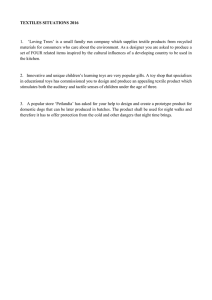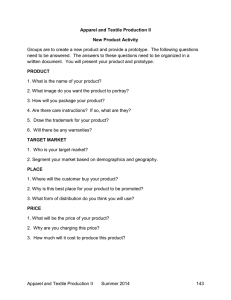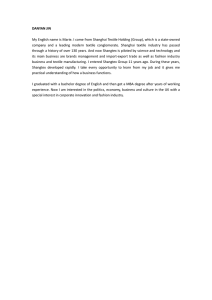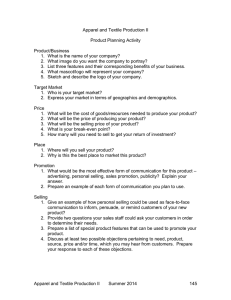Productivity in the Textile Industry
advertisement
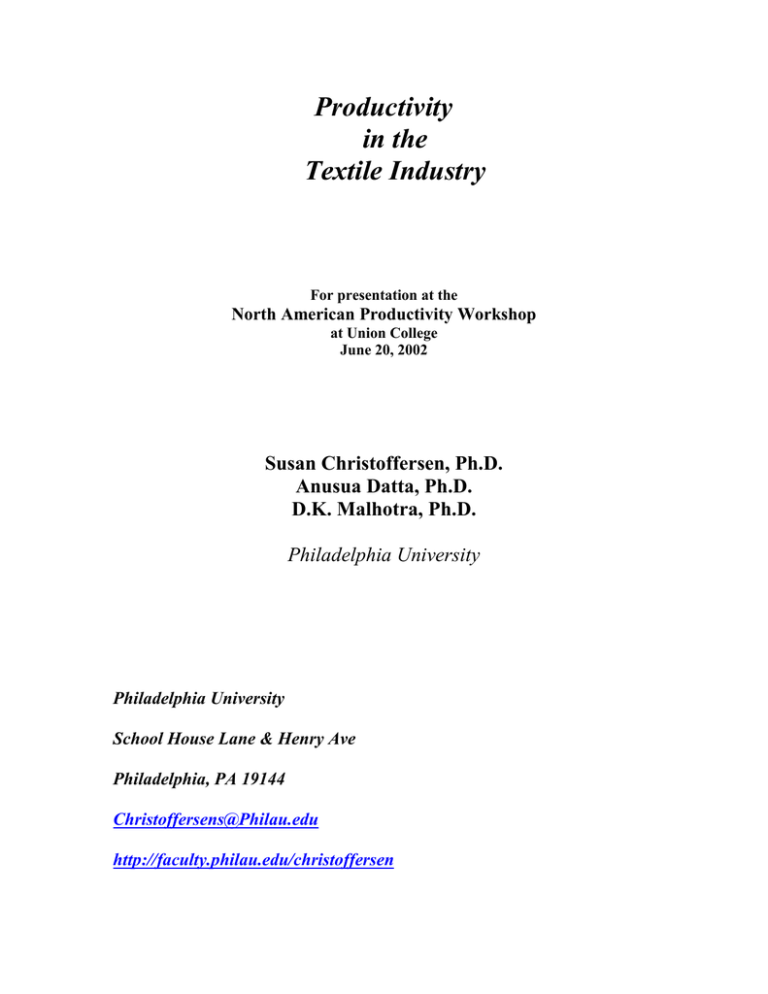
Productivity
in the
Textile Industry
For presentation at the
North American Productivity Workshop
at Union College
June 20, 2002
Susan Christoffersen, Ph.D.
Anusua Datta, Ph.D.
D.K. Malhotra, Ph.D.
Philadelphia University
Philadelphia University
School House Lane & Henry Ave
Philadelphia, PA 19144
Christoffersens@Philau.edu
http://faculty.philau.edu/christoffersen
Motivation
“Tell Me What’s Going On” – Marvin Gaye
The Textile Industry
News regarding the difficulties facing textile firms proliferates yet, despite
the disappointments, there is also hope.
employment is declining in the textile sector
production is increasing
firms are going out of business in large numbers
new efficient and innovative firms are entering
increasing volume of imports
volume of exports is also increasing
James Levinsohn and Wendy Petropoulos of the National Bureau of
Economic Research (NBER) calculated these rates based on plant level data
collected by the Census Bureau.
turnover in the apparel industry has been considerably higher
textile rates do not significantly diverge from the overall
manufacturing rates.
Table 1: Rates of Plant Entry and Exit
Gross Rate of
Entry
Gross Rate of
Exit
Textiles
1972-77
1977-82
1982-87
1987-92
26%
31%
20%
28%
32%
32%
38%
31%
Apparel
1972-77
1977-82
1982-87
1987-92
42%
48%
25%
49%
44%
43%
55%
46%
Undeniably disappointing news is frequently broadcast regarding the
declining levels of employment in the textile industry.
While not minimizing in any way the hardship this represents, employment
losses are consistent with evolving production technologies.
Chart 1:
Employment Trends in the Textile Industry
1400
1000
800
600
400
200
Time
All Employees
Production Workers
Non-Production Workers
Bureau of Labor Standards (BLS)
1999
1996
1993
1990
1987
1984
1981
1978
1975
1972
1969
1966
1963
1960
1957
1954
1951
1948
1945
1942
0
1939
Employees ('000s)
1200
Employment trends in textiles do not diverge terribly from other
manufacturing sectors.
Mean for Job Creation=8.3, Job Destruction=10.33
Chart 2:
Comparison of Average Annual Employment Flows by Industry (1974-1992)
14
12
10
8
6
4
JOB CREATION (+VE)
JOB DESTRUCTION (-VE)
Reflects general shift to service v. manufacturing economy.
MISCELLANEOUS (39)
TRANSPORTATION (37)
ELECTRICAL
MACHINERY (36)
NONELECTRICAL
MACHINERY (35)
FABRICATED METALS
(34)
Industries
PRIMARY METALS (33)
STONE, CLAY, GLASS
(32)
LEATHER (31)
RUBBER (30)
PETROLEUM (29)
CHEMICALS (28)
PRINTING (27)
PAPER (26)
FURNITURE (25)
LUMBER (24)
APPAREL (23)
TEXTILE (22)
0
TOBACCO (21)
2
FOOD (20)
Job Creation and Job Destruction
16
Technological progress affects how labor is employed in industry.
Labor use has been cut in half
Materials, Purchased Services and Energy use have doubled
Since 1996, both Productivity and Capital Services have increased
about 10 % with the remaining inputs declining about 10 % (Bureau
of Labor Standards).
Real Sector Input quantities and Productivity: Comparision of Capital Services,
Labor Hours, Energy, Materials, Purchased Services and MFP
200
PRODUCTIVITY INDEXES
180
160
140
120
100
80
60
40
20
1999
1997
1995
1993
1991
1989
1987
1985
1983
1981
1979
1977
1975
1973
1971
1969
1967
1965
1963
1961
1959
1957
1955
1953
1949
0
TIME
CAPITAL SERVICES
ENERGY
PURCHASED SERVICES
LABOR HOURS
MATERIALS
MULTIFACTOR PRODUCTIVITY
Textile production - the continual adaptation of higher technology.
Capital Labor Ratios for Textiles
8
7
5
4
3
TIME
K/L
1999
1998
1997
1996
1995
1994
1993
1992
1991
1990
1989
1988
2
1987
RATIO
6
The overriding barometer of how well the high tech strategy is working:
the impact on productivity
Compared to the apparel industry, textiles has had twice the rate of
productivity growth
the productivity growth of the textile industry has outpaced
productivity growth of all manufacturing sectors
According to Cline (1990), productivity gains, not import penetration,
have had the largest impact on employment in the textile industry.
MFP for Textiles and Apparel and Labor Productivity for Textiles
120
110
100
80
70
60
50
40
30
TIME
SIC 22
SIC 23
OUTPUT PER UNIT of L
So the industry is doing great? Well, despite the improvements, it remains
one of the sectors with the lowest productivity.
1999
1997
1995
1993
1991
1989
1987
1985
1983
1981
1979
1977
1975
1973
1971
1969
1967
1965
1963
1961
1959
1957
1955
1953
20
1949
MFP
90
Can the textile industry improve productivity?
Using the total factor productivity index of textile firms, this study will
assess the impact of investments in R&D, IT, capital and labor.
Our objective is to develop a model that will measure the relative impact of
the various investments on productivity using both industry (2 digit) and
sector (4 digit SIC) level data.
R&D investment is problematic
uncertain pay-off
difficult to project the profitability of potential inventions
new products and processes must divert productive resources towards
implementation. Such adjustment costs for R&D related projects are
estimated to be seven times the adjustment costs of investment in new
plant and equipment.
IT is problematic
extremely long lags
not fully appreciated
Productivity Literature
Productivity studies (Mairaisse and Griliches, 1990) often cover a large
sector of the economy, such as the manufacturing sector. These studies then
report the impact of aggregate levels of capital investment on the overall
manufacturing productivity of the economy.
Based on this evolving area of methodological approaches(Levinsohn
& Petrin, 2001), increasing access to data, we feel a sectoral or plant
level analysis is a fruitful area of research.
The contribution of technology to increased output, productivity and
the stock market valuation of a firm has been shown to be significant
in many industry studies, however the textile industry has been
neglected.
The importance of technology was first recognized when estimates of
production functions initially showed unacceptably large residuals; that is,
output was greater than one would have expected from given inputs of labor
and capital (Abramovtz, 1956, Kendrick, 1956, and Solow, 1957).
These residuals were later attributed to technological growth; greater output
was due to the more efficient deployment of those inputs as a result of
technological change. (Denison, 1962 and Griliches & Jorgenson, 1967).
Then in the 1970’s there was a slowdown in productivity growth that could
be explained by diminishing returns to science and technology. Thus the
relationship between productivity and technological growth was understood
to be positive but with a diminishing horizon (Nordhouse, 1972 & 1989,
Olson, 1982, Scherer, 1983, and Baily & Chakrabati, 1988).
Denny, Fuss and Waverman (1981) have shown that for large, capitalintensive industries, cost savings can result from realization of scale
economies and increased competition, besides technical change.
Recent studies on productivity growth for the U.S. have also identified
information technology (IT) as an important source of productivity gain
through lower transactions cost and improved market information. For the
textile industry the potential for IT investment lies in “supply-chain
management” and “quick response” which helps lower costly inventory
build-up.
This is one of the most complex yet vital issues in today’s business world
(Griliches, 1998).
Industry Level Estimation
Productivity measures the growth in output not explained by the growth in
inputs. A typical production function for a firm can be written as:
f(q, x) = 0,
(1)
where q is a vector of outputs, and x is a vector of all inputs. TFP is
measured as the ratio of aggregate real output (Q) divided by aggregate real
input (X), as TFP=Q/X. The instantaneous rate of growth of TFP is then
given by
TFP Q X
(2)
Equation (1) is estimated using level values for the dependent and
independent variables:
TFPt = a10 + a11 Outputt+ a12 KLRatiot+ a13 R&D-Intensityt
+ a14 Import Competition+ a15 ITKRatiot + 1t
(1)
TFP is the total factor productivity index for the textile industry at the 2-digit level;
Output measures real output, KLRatio measures capital intensity; R&D-Intensity is the
ratio of R&D employment to total employment or alternatively R&D expenditure as a
share of total output. Import Competition is the captured by the ratio of imports to exports
or the ratio of imports to domestic production. Finally, ITKRatio measures the value of
real IT capital as a share of total capital.
R2 and t-values may be high simply because of common trends in the
dependent and independent variables. In order to ascertain that the results
from the above model are not spurious we estimate equation (2) in terms of
growth rates.
TFP t =
b10 + b11 Q + b12 KLR + b13t RD t + b14 I MPEN
+ b15 ITKR + 1t
Estimation results follow.
(2)
Table 1: Dependent Variable LNTFP Level Effects:
(1)
2.025
(17.51)**
(2)
0.604
(1.70)*
LNQ
0.378
(9.91)**
0.717
(7.95)**
KL Ratio
0.855
(11.02)**
0.778
(8.07)**
0.0025
(2.9)**
0.0016
(2.13)**
Intercept
IM-EX Ratio
RDEmpl-ratio
3.148
(2.18)**
ITCapital-Ratio
-0.0002
(-2.68)**
R2 (adj.)
0.98
0.98
Note: Figures in parentheses represent t-statistics
Both models have a high overall significance of 0.98 and all coefficients are significant at
the 5% and 1% level.
Positive correlation between KL Ratio (capital-labor ratio) and TFP indicates increased capitalization and downsizing have a positive impact.
Coefficient of Import Competition, measured as the ratio of Imports to
Exports – indicates although the impact is small, increased competition
forces domestic firms to become more efficient.
RDEmp, measures the share of R&D employment to total
employment – shows investment in human capital improves productivity.
ITCapital, measures the extent to which investment in computers and
software improves productivity. The coefficient value is small but
significantly negative. This result seems to be in keeping with other studies
in textiles, which find no significant relationship between investment in
information technology and growth.
Level Effects: Estimates using Import Penetration and R&D Expenditure
Table 2: Dependent Variable lnTFP
Intercept
(1)
1.233
(3.49)**
LnQ
0.586
(8.72)**
KL Ratio
0.430
(4.83)**
IM-PEN
0.0011
(0.176)
RDExpd
0.132
(2.99)**
ITCapital-Ratio
-0.0052
(-2.20)**
Adj. R2
0.99
Import Penetration (IM-PEN): the ratio of imports to domestic production.
R&D Expenditure (RDExpd): An issue with using R&D employment is
that it may not reflect the effect of R&D capital on productivity growth.
However, the data on R&D expenditures was fraught with problems. We
estimated the missing values by fitting a non-linear regression line through
the available data. This variable was then used in the above regression.
The results in Table 2 are comparable with those in Table1. The log of
output, and capital-labor ratio are all positive and significant. R&D
measured in expenditure terms is also significant and positive. Import
penetration although positive is not significant. The effect of IT capital
remains negative and significant.
MODEL: Dependent Variable: TFP Growth - Growth Effects
Intercept
Q
KLR
I MPEN
(1)
0.001
(1.59)
(2)
0.001
(1.79)
0.352
0.321
(2.33)**
(2.17)**
0.350
(2.31)**
0.343
(2.39)**
-0.0074
(-0.64)
0.002
(1.28)
I M EX
0.003
(1.24)
0.003
(1.23)
-0.0074
(-1.98)**
-0.0086
(-2.4)**
RDR (Empl)
ITKR
R2
0.65
The growth rates estimates indicate that the results from the level effects are
robust. The coefficient for output (Q) growth and growth rate of capital
intensity (KLR) remain positive and significant. When measured in growth
terms the coefficient of output measures scale effects. The value is positive
but less than 1. This indicates that an increase in capital intensity is
associated with an increase in productivity. The effect of the growth in R&D
employment is positive but not significant. The effect of the growth in ITcapital investment on productivity remains negative. The cost of investment
in computers etc. may outweigh the returns in the initial stages. The
coefficient for import penetration (Im/Q)is negative but insignificant.
However, when measured as the ratio of imports to exports, import
competition is positive but insignificant.
Comparison of Productivities of Sectors
130
PRODUCTIVITY INDEXES
125
120
115
110
105
100
95
90
85
1996
1995
1994
1993
1992
1991
1990
1989
1988
1987
80
TIME
SIC 221 - Broadwoven Fabric mills, Cotton.
SIC 223 - Broadwoven fabric mills, wool
SIC 225 - Knitting mills
SIC 227 - Carpets and rugs
SIC 229 - Miscellaneous textile goods
SIC 222 - Broadwoven fabric mills, manmade
SIC 224 - Narrow fabric mills
SIC 226 - Textile finishing, except wool
SIC 228 - Yarn and thread mills
Note that in Chart Four, seven of the nine sectors experienced productivity
gains. Broadwoven cotton mills (cotton, not wool) and yarn and thread mills
were only 95% and 97% as efficient as a decade ago, attributable to excess
capacity. The other sectors all experienced productivity gains during the
decade preceding NAFTA. This is an important observation for the debate
over trade protections. Advocates of free trade argue that protections foster
inefficiency, allowing the industry to stand behind tariff walls rather than
adjust to the competitive pressures of an increasingly global economy. The
textile industry has continually achieved efficiency gains while tariffs and
quotas were in place.
Thank you for your attention, and
I welcome your comments and suggestions.
